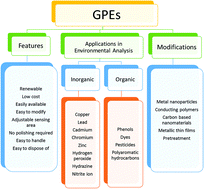Graphite pencil electrodes as electrochemical sensors for environmental analysis: a review of features, developments, and applications
Abstract
Graphite pencil electrodes (GPEs) are carbon-based electrodes that are recognized by their low cost, simplicity, commercial availability, ease of modification and disposability. GPEs are attractive substrates for electrochemical sensing because of their unique feature of “disposability” compared to other commonly used carbon-based electrodes. Mechanically rigid GPEs are easy to modify and miniaturize. The sensitivity and selectivity of GPE toward certain analytes can be enhanced by applying different modification materials. The primary focus of this review article is to highlight the applications of GPEs in the analysis of inorganic and organic pollutants in different environmental matrices. This review gives a brief overview of the various types of inorganic and organic pollutants and their impact on the environment. The key features of modified GPEs that enhance their electrocatalytic activity toward detection of certain target analytes are critically appraised. In the end, we summarize the current status, weaknesses and future prospects of GPE based sensors for environmental analysis.


 Please wait while we load your content...
Please wait while we load your content...